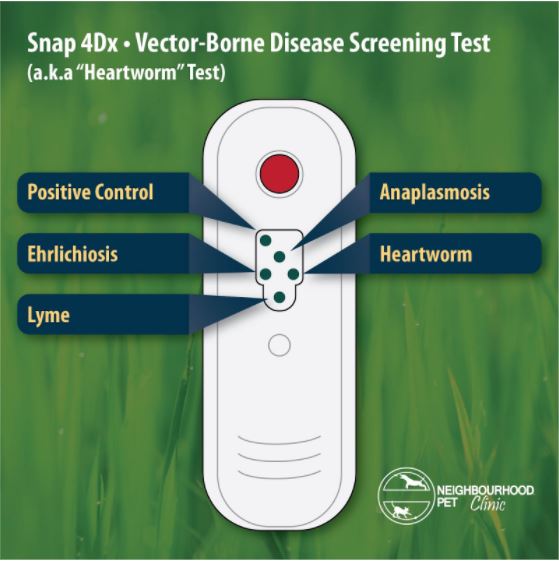How To Prevent Parasites For Dogs

Parasite Prevention for Dogs
Dogs can truly make a house a home. They’re excellent door-greeters and couch-snugglers, but unfortunately they also make very hospitable hosts for a variety of unwelcome parasites!
Not only do parasites affect our furry family members’ quality of life, but the ones that target our canine companions can also carry risks that affect our whole families. Fortunately, we can keep these dangerous critters at bay with a personalized parasite prevention plan.
These parasites are here in London:
These are the parasites that we are concerned about in our area. Preventative products are available, but they’re not one-size-fits-all.
Your veterinarian can work with you to create your pet’s personalized prevention plan, taking into account their medical history, the other pets in the household, and their risk factors. We’ll help you find the best product, or combinations of products, to keep your little one safe.
Click below to learn more.
Protecting Your Dog — and Your Family — from Parasites
Dogs can truly make a house a home. They’re excellent door-greeters and couch-snugglers, but unfortunately, they also make very hospitable hosts for a variety of unwelcome parasites!
Not only do parasites affect our furry family members’ quality of life, but the ones that target our canine companions can also carry risks that affect our whole families. Fortunately, we can keep these dangerous critters at bay with a personalized parasite prevention plan.
Heartworm

Intestinal Worms

Fleas

Ticks

Mange
Understanding Your Dog’s Heartworm Test
When temperatures become milder, hungry parasites emerge from their dormant states. Around this time, your veterinarian will likely emphasize the importance of coming in for your furry family member’s annual parasite prevention and heartworm test. But what is that “heartworm test” exactly, and why is it so important?

What is a heartworm test?

What are those diseases?

Why is testing important?

What is a heartworm test?

What are those diseases?

Why is testing important?

Is an exam and blood test important?

Is an exam and blood test important?

What about cats?
Screening Test
FAQs about Parasite Prevention
Why is seasonal parasite prevention important?
Most parasites tend to lie dormant in cold weather and become active during warmer months. These parasites can transmit diseases to your pet that can make them ill and, in some cases, even fatal.
There are many types of parasites, and different products protect against different parasites. Talk to your veterinarian or a veterinary technician to determine which product is best for your pet’s lifestyle and risk factors.
My dog hardly, or never, goes outdoors. Should they still receive parasite prevention?
Yes. Ticks can hitch a ride indoors on other members of the family, and one kind can even live in your baseboards. Mosquitoes, which transmit heartworm, can easily access a balcony, front porch, or come inside the home. Additionally, fleas and other parasites can actually infest indoor areas, especially apartments and shared buildings.
When can my puppy have parasite prevention?
Most products are designed for puppies over eight weeks of age. However, with growing pets, we recommend that they come in monthly to be weighed so that we know we are giving them the correct dosage for their size. We will dispense their prescriptions month-to-month based on their weights.
Does my puppy need a heartworm (4DX) test?
If your puppy was born in the winter, they should not need a heartworm/4DX test, since it is unlikely that they were exposed to mosquitoes during the cold months. Additionally, it takes a minimum of 5 months from the time a dog is bitten by an infected mosquito until a positive 4DX test can result. That is why we do most heartworm testing in the spring – 5 months after the last possible mosquito bite.
Your puppy should be on parasite prevention starting in the spring. For some preventatives, a negative heartworm test will be required prior to starting prevention. Because your puppy will be growing, their dosing will change, and we will want to conduct monthly weigh-ins and dispense preventatives on a month-to-month basis.
How much is a heartworm (4DX) test?
The test costs around $50, but you may want to consider bundling it with Wellness Bloodwork. The company we use for external labs and diagnostics, IDEXX, often has a seasonal sale this time of year (March 1 – July 31) on blood profiles that include the 4DX test. These panels look at some common parameters in your dog’s blood, which gives us an overall indication of organ function and establishes a baseline to compare any future bloodwork.
Which products are available for parasite prevention?
For dogs, we typically recommend Nexgard Spectra or Simparica Trio to protect against fleas, ticks, heartworm, and other parasites from June to November. Sometimes we will use Multi-Duo. These are all broad-spectrum products from different companies. We will help you find the best option for your household.
We recommend protecting against fleas and ticks throughout the rest of the year, but especially in April and May. Products with a tick focus may include regular Nexgard or Simparica.
If you have cats in the household, they will also need to be on prevention in order for the products to be effective at keeping parasites out of the home. We typically recommend Revolution Plus for cats.
We also stock Bravecto, Capstar, Profender, Milbemax, Interceptor and Advantage.
How do I know which prevention is right for my furry family member?
Every pet is unique, and parasite prevention isn’t one-size-fits-all, so your veterinarian or veterinary technician is always the best resource to find the ideal prevention for your pet’s lifestyle, considering the other pets in the household and their medical history.
Typically, prevention for dogs is divided into two categories by preference: topical or oral.
• Some families prefer an oral preventative (looks like a treat) such as Nexgard Spectra or Simparica Trio
• For topical (a tube of liquid administered behind the shoulders), we typically go to Multi-Duo, but it cannot be used if there are cats in the house
Note: Revolution (a topical preventative) was once the go-to parasite prevention for dogs. However, it is no longer the best choice as it does not provide adequate tick protection, as more tick species become endemic to our area. We recommend a product by the same manufacturer called Simparica Trio.
As always, a veterinarian is the best source of information and may have other recommendations based on your pet’s needs.
When should I give my dog their prevention?
The most important time to have your dog on parasite prevention is between June and November, as this is when heartworm is a concern.
Ticks become active in mild temperatures, as low as 0-4 degrees Celsius, so we also recommend flea and tick protection in the milder months, especially April and May.
You may wish to consider year-round prevention anyway, especially with our fluctuating temperatures and if you plan any travel with your dog during the winter months.
Parasite prevention should typically be given on the same day each month to ensure its effectiveness, but please confirm with your veterinarian for the details of your dog’s specific products.
Why do I need to pay for an examination to buy these products?
These are prescription medications, and just like any prescription, a veterinarian must ensure that the patient is in good enough health to receive them. For efficacy and your pet’s safety, they will also determine the best type of medication and dosage.
However, if your pet has had an examination in the last year (and is in good health and not growing/changing weight), your veterinarian may use their discretion to dispense the prescription without another examination. They may also request a recent weigh-in or a heartworm test before dispensing.
I found a tick on my dog. What should I do?
The tick should be removed by grasping it near the head with a pair of tweezers and with steady, even upward pressure, withdrawing the mouth parts from where they are buried in the skin. We have a special tick removal tool available for this purpose. Remember to wash your hands afterwards, and if you must use your hands, always wear gloves.
The removed tick should be disposed of as soon as possible to reduce the likelihood of transmitting disease, or you may wish to preserve it in rubbing alcohol and bring it to us for identification of the tick species and the associated risks.
If you are not comfortable removing the tick yourself, a veterinary technician will help you. It is important to get the whole tick out and monitor the site for any signs of irritation or infection afterward. Then, contact your veterinarian for the next steps.
We always recommend doing a 4DX test on any dog four weeks following a confirmed tick bite for dogs that are not on prevention.
I found a flea/tick on my dog, but it’s on prevention! Why isn’t it working?
Most products require the parasites to bite in order to kill them. The tick will die within a few hours and fall off.
Why can’t I just give Revolution to my dog? That’s what I always used to use.
Five to ten years ago, ticks just weren’t as prevalent in our area as they are now. Now, every year, we see tick-borne diseases in our furry friends who were not on adequate tick prevention the year before.
Revolution was fine at one point for heartworm coverage and some internal parasites, but it only protects against one type of tick, and does not protect against the black-legged/deer tick, which transmits Lyme disease. Canine Revolution is no longer considered adequate parasite prevention on its own.
We now recommend switching to Simparica Trio, which is made by the same company as Revolution. It is an all-in-one chewable tablet that protects against fleas, heartworm, internal parasites, and many ticks, including the one that carries Lyme disease. We recommend giving it from June to November.
Outside of that window, heartworm is less of a concern, but ticks are still active. You may wish to consider additional tick protection in the early spring and milder winter months, such as giving regular Simparica (tick protection only) in April and May.
If you prefer a topical solution, a veterinary technician can discuss whether switching to another product line, such as K9 Advantix II and Advantage Multi, might be an option for your furry family member.
How much are these products?
For most, the prices vary quite a bit by weight category. Bigger Pet = Bigger Price.
If you have an idea of what your pet’s weight is, we can help you find the corresponding cost. For the cost-conscious dog owners, Multi-Duo generally has the lowest price, but all forms of prevention are quite comparable across the different brands.
Most products are packaged to cover a six-month treatment window, with treatments given once monthly. For each product, you usually have the option to buy one month’s treatment at a time instead of the whole six-month supply. The cost works out to be the same per treatment; however, there is a $5 dispensing fee every time. Therefore, it is better value to buy a full pack and only pay the dispensing fee once.
For dogs, there are two product options that “do it all” that are to be given from June to November: Nexgard Spectra or Simparica Trio. In the past, we would have to use two products combined to do what each product can do individually (i.e. Nexgard + Heartgard or Simparica + Revolution). It is a bit more cost-effective to buy the all-in-one product than to buy its two corresponding combo products individually.
We recommend tick protection outside of the June-November window, though, and especially in April and May when temperatures are consistently mild. Heartworm is not so much of a concern during this time, so for a tick-focused protection, such as regular Simparica or Nexgard, it’s usually about half the cost of prevention for the summer months. The exact cost will vary depending on your dog’s size, though.
If you have any questions about your dog’s parasite prevention plan or if you’re ready to protect your pet this season, we’re here to help!
Heartworm
Transmitted by: Infected mosquitos
Risks: Lives in and around the heart, causing heart failure and damage to other organs
Who is affected: Dogs (can be fatal if untreated)
*Note: Rare in cats but risk is increasing

Intestinal worms
(hookworm, roundworm, whipworm)
Transmitted by: Ingesting the eggs containing larvae
(Often through consuming infected feces)
Risks: They rob the body of nutrients causing GI symptoms, anaemia and even death.
Who is affected: Dogs, cats
*Note: Can be transmitted to humans

Fleas
Transmitted by: Other animals/ picked up outside or in infested areas (ex. apartments)
Risks: Extreme discomfort from bites, anaemia. Can also carry intestinal parasites (ex. tapeworm).
Who is affected: Dogs, cats
*Note: Will bite humans

Ticks
(Most commonly the American Dog Tick, Blacklegged/deer tick, Lonestar tick, Brown dog/wood tick, and Gulf Coast tick)
Transmitted by: Picked up outside or in infested areas, burrows in skin to feed where it can then transmit disease
Risks: Depending on the species of tick:
– Lyme disease (lameness, pain in joints)
– Ehrlichiosis (Fever, weight loss, respiratory distress)
– Anaplasmosis (joint pain, fever, lethargy)
Who is affected: Dogs
Cats can carry ticks but have a very low risk of developing tick-borne diseases

Mange
(Sarcoptic Mange/ scabies, Demodectic Mange/ red mange/ demodex)
Transmitted by: Skin disease caused by mites. Picked up from other animals/infested areas
Risks: Extreme itchiness, rash, infection, hair loss
Who is affected: Dogs, cats
Note: Some forms are transmissible to humans

What is a heartworm test?
More accurately called a “parasite screening test,” this test also typically screens for common tick-borne diseases such as Ehrlichiosis, Lyme, and Anaplasmosis. A drop of your dog’s blood is placed on a test strip, which will indicate whether the dog has an antigen to heartworm disease or antibodies to one of the tick-borne diseases.

What are those diseases?
Heartworms are transmitted by mosquitoes. These parasites live in and around the heart, causing heart failure and damage to other organs. Lyme disease symptoms include lameness and joint pain, while Ehrlichiosis includes fever, weight loss, and respiratory distress. Anaplasmosis involves joint pain, fever, and lethargy.

Why is testing important?
Annual testing for parasite-borne diseases allows early diagnosis and treatment before symptoms become severe. A positive test result would affect your pet’s prevention and treatment plan. It is recommended in the spring because it must be performed at least five months after the last possible mosquito bite.

Is an exam and blood test mandatory?
As with any prescription, your pet must have had an exam recently enough for the doctor to be familiar with their health. Some parasite preventatives are not recommended for heartworm-positive pets, so in those cases, a parasite screening test may also be required. Your veterinarian will use their discretion to determine the safest way to proceed, based on product requirements, your dog’s age, and medical history.

What about cats?
Cats should still be on parasite prevention for their well-being and that of their families. However, they are significantly less likely to contract heartworm or tick-borne diseases themselves, so they typically do not undergo parasite screening.

Snap 4Dx
As with many things in life, an ounce of prevention is worth a pound of cure. By preventing, testing, and treating the diseases carried by mosquitoes, fleas, ticks, and internal parasites, we can prevent illness and discomfort for our furry family members while protecting our families and our communities, too.


